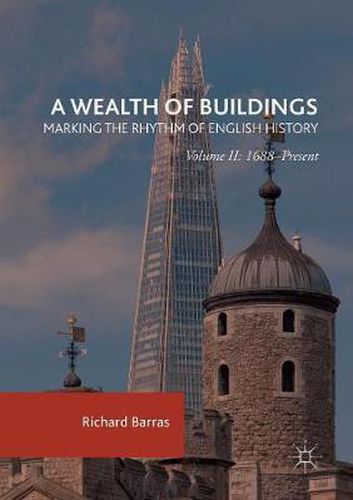Readings Newsletter
Become a Readings Member to make your shopping experience even easier.
Sign in or sign up for free!
You’re not far away from qualifying for FREE standard shipping within Australia
You’ve qualified for FREE standard shipping within Australia
The cart is loading…






This title is printed to order. This book may have been self-published. If so, we cannot guarantee the quality of the content. In the main most books will have gone through the editing process however some may not. We therefore suggest that you be aware of this before ordering this book. If in doubt check either the author or publisher’s details as we are unable to accept any returns unless they are faulty. Please contact us if you have any questions.
This two-volume book explores how the great buildings of England bear witness to a thousand years of the nation’s history. In every age, investment in iconic buildings reaches a climax when the prevailing mode of production is operating most effectively, surplus wealth is most plentiful, and the dominant class rules supreme. During such periods of stability and prosperity, the demand for new buildings is strong, structural and stylistic innovations abound, and there is fierce competition to build for lasting fame. Each such climax produces a unique vintage of hegemonic buildings that are monuments to the wealth and power of those who ruled their world.
This second volume presents three case studies of iconic building investment from the eighteenth century to the present day. During the eighteenth century the wealth of the great landed estates funded the golden age of country house building by aristocracy and gentry. During the nineteenth century the Industrial Revolution unleashed an unprecedented wave of infrastructure investment and civic building by the ascendant capitalist class. Since the late twentieth century the power of global financial capital has been symbolized by the relentless rise of city centre office towers. A final chapter argues that these different forms of hegemonic building are a physical manifestation of the underlying rhythm of English history.
$9.00 standard shipping within Australia
FREE standard shipping within Australia for orders over $100.00
Express & International shipping calculated at checkout
This title is printed to order. This book may have been self-published. If so, we cannot guarantee the quality of the content. In the main most books will have gone through the editing process however some may not. We therefore suggest that you be aware of this before ordering this book. If in doubt check either the author or publisher’s details as we are unable to accept any returns unless they are faulty. Please contact us if you have any questions.
This two-volume book explores how the great buildings of England bear witness to a thousand years of the nation’s history. In every age, investment in iconic buildings reaches a climax when the prevailing mode of production is operating most effectively, surplus wealth is most plentiful, and the dominant class rules supreme. During such periods of stability and prosperity, the demand for new buildings is strong, structural and stylistic innovations abound, and there is fierce competition to build for lasting fame. Each such climax produces a unique vintage of hegemonic buildings that are monuments to the wealth and power of those who ruled their world.
This second volume presents three case studies of iconic building investment from the eighteenth century to the present day. During the eighteenth century the wealth of the great landed estates funded the golden age of country house building by aristocracy and gentry. During the nineteenth century the Industrial Revolution unleashed an unprecedented wave of infrastructure investment and civic building by the ascendant capitalist class. Since the late twentieth century the power of global financial capital has been symbolized by the relentless rise of city centre office towers. A final chapter argues that these different forms of hegemonic building are a physical manifestation of the underlying rhythm of English history.